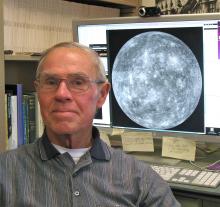
A Distinction at the Cosmic Level
The late Stanton J. Peale, for whom asteroid 3612 was named, has been selected to receive — posthumously — the American Astronomical Society’s 2016 Gerard P. Kuiper Prize in recognition of his outstanding contributions to the field of planetary science. The award is presented by the society’s Division for Planetary Sciences (DPS).
A professor emeritus of physics at UC Santa Barbara who died in May 2015, Peale is recognized for his “substantial and broad contributions, particularly in the areas of planetary dynamics, planetary interior and the search for extrasolar planetary systems.” Peale’s applications of rigorous mathematical modeling to understand the interiors of planets and moons led to the prediction that Jupiter’s moon Io, discovered by Galileo, would exhibit active volcanic eruptions as a result of the action of tides.
Soon after his prediction, dramatic photographs sent back from the two Voyager missions in 1979 proved him right.
Peale also predicted that the planet Mercury has a molten inner core, which was confirmed by radar observations. His other significant contributions include studies of a liquid ocean on Europa (another of Jupiter’s moon discovered by Galileo) and the chaotic tumbling of Saturn’s moon Hyperion.
Peale’s work illustrated the power of physics to probe the interiors of planets.
“Stan Peale was one of the founding members of the astrophysics group within the Department of Physics at UCSB, which has now grown to 10 faculty,” said Omer Blaes, professor and former chair of the physics department and a member of the astrophysics group. His dedication to the very highest ideals of scientific research and teaching, as well as his kindness to others, were an inspiration to us all.”
The recipient of numerous honors and awards, Peale was elected to the National Academy of Sciences and was a Fellow of the American Association for the Advancement of Science and of the American Geophysical Union. His research was further recognized through the Newcomb Cleveland Prize of the American Association for the Advancement of Science; the James Craig Watson award of the National Academy of Sciences; the Dirk Brouwer Award of the Division on Dynamical Astronomy of the American Astronomical Society; and the NASA Exceptional Achievement Medal.
The Kuiper Prize is the most prestigious award bestowed by the DPS. Previous recipients include Carl Sagan, Fred Whipple, Peter Goldreich and James Van Allen. The 2016 prize will be presented at the joint 48th meeting of the Division for Planetary Sciences and 11th European Planetary Science Congress in Pasadena, California, in October.



